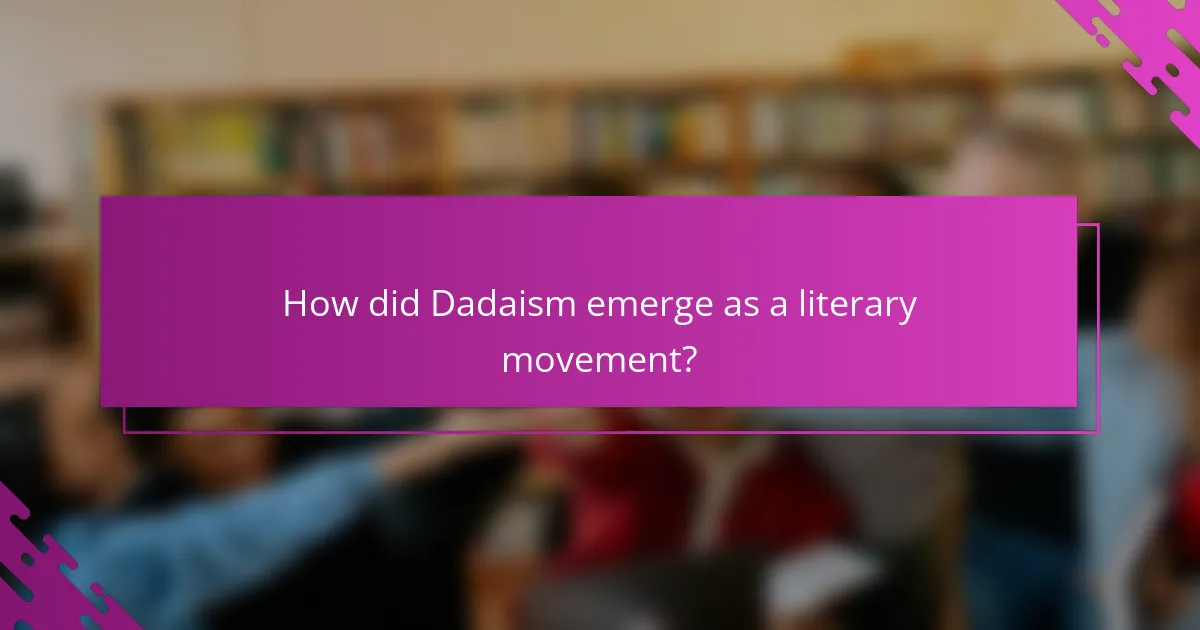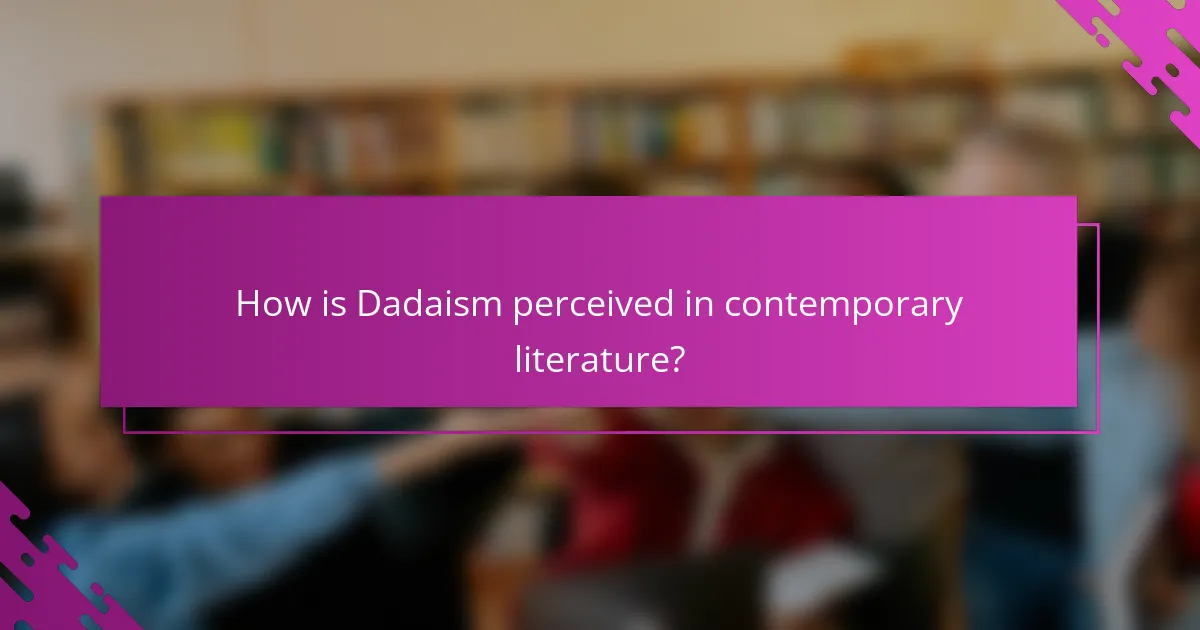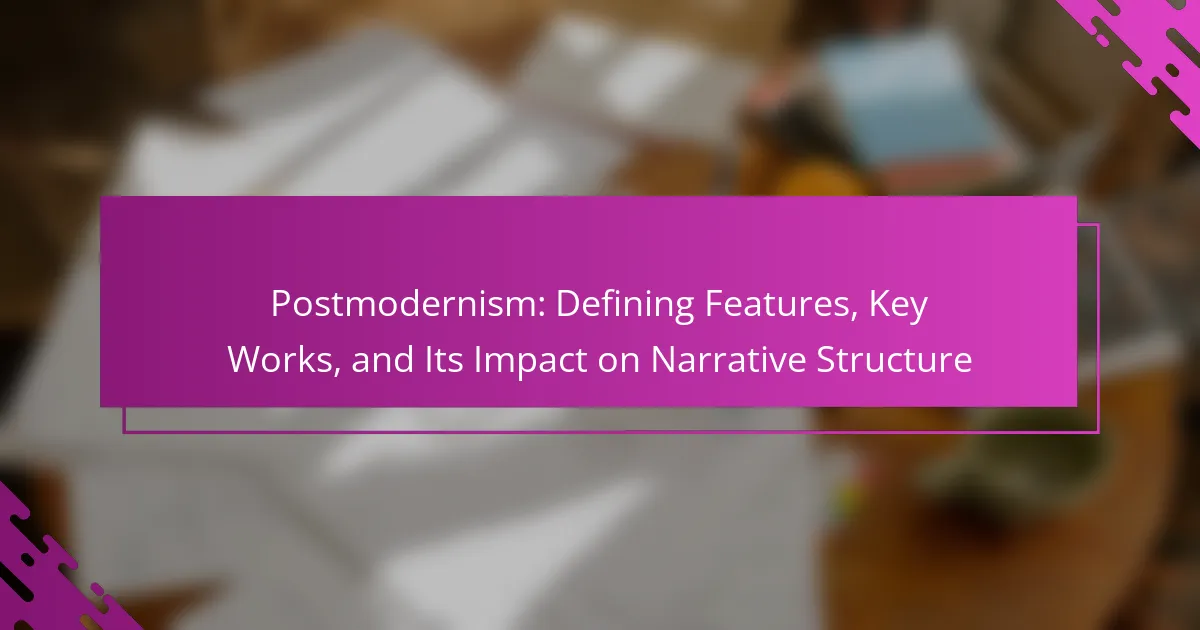Dadaism in literature challenges conventional norms and embraces chaos, reflecting the turmoil of World War I. This article explores key attributes of Dadaist works, provides historical context, and examines its lasting influence on modern literature. Key figures like Tristan Tzara and Hugo Ball utilized absurdity and anti-art sentiments, shaping the discourse around creativity and expression today. The movement’s legacy continues to inspire contemporary writers to question reality and meaning.

How did Dadaism emerge as a literary movement?
Dadaism emerged as a literary movement in response to the horrors of World War I. It rejected conventional aesthetics and embraced chaos and absurdity. Originating in Zurich around 1916, Dadaism sought to challenge societal norms and artistic conventions. Key figures included Tristan Tzara and Hugo Ball, who used provocative language and unconventional forms. Dadaism’s influence persists in modern literature, inspiring postmodernism and experimental writing. Its unique attribute lies in its anti-art stance, questioning the very nature of art and meaning.
What were the socio-political influences on Dadaism?
Dadaism emerged as a reaction to the socio-political turmoil of World War I. It challenged traditional artistic norms and reflected the disillusionment with societal values. The movement was influenced by anti-war sentiments, political upheaval, and the rise of totalitarian regimes. Artists used absurdity and chaos to critique the logic that led to war, merging art with activism. This unique attribute of Dadaism fostered a legacy that continues to resonate in modern art and literature, encouraging ongoing questioning of authority and societal norms.
Which key figures shaped Dadaism in literature?
Key figures who shaped Dadaism in literature include Tristan Tzara, Hugo Ball, and Marcel Duchamp. Tzara, as a founder, articulated Dada’s principles through manifestos. Ball’s performances and poetry embodied Dada’s spontaneity. Duchamp introduced anti-art concepts, challenging traditional aesthetics. Each contributed uniquely to Dada’s literary legacy, influencing modernist movements.

What are the defining characteristics of Dadaist literature?
Dadaist literature is characterized by absurdity, anti-art sentiments, and a rejection of traditional narrative forms. It often embraces randomness and spontaneity, reflecting the chaotic nature of the early 20th century. Dadaists utilized unconventional structures, such as collage and cut-up techniques, to challenge societal norms. This literary movement aimed to provoke thought and question the meaning of art and literature itself. Through its unique attributes, Dadaism remains influential in contemporary avant-garde writing.
How does Dadaism challenge traditional literary forms?
Dadaism challenges traditional literary forms by embracing absurdity, randomness, and anti-art sentiments. This movement rejects conventional narrative structures and coherent meaning, favoring fragmented and chaotic expression. Dadaism’s unique attribute lies in its use of unconventional materials, such as found objects and collage, which disrupt established norms. As a result, it encourages readers to engage with texts in new, unpredictable ways, fostering a deeper exploration of meaning and artistic intent.
What themes are prevalent in Dadaist works?
Dadaist works often explore themes of absurdity, anti-art, and the critique of rationality. These themes reflect a rejection of traditional aesthetics and societal norms. Dadaism emerged as a response to the chaos of World War I, emphasizing spontaneity and irrationality. The movement’s focus on chance and the nonsensical highlights its unique attribute of challenging conventional artistic expression. Additionally, Dadaism’s influence is seen in modern art and literature, as it continues to inspire artists to question meaning and context.

In what ways did Dadaism influence later literary movements?
Dadaism significantly influenced later literary movements by promoting anti-establishment ideas and embracing absurdity. Its emphasis on spontaneity and irrationality paved the way for Surrealism and Postmodernism. Dadaism’s rejection of traditional narrative forms inspired writers to explore fragmented structures and unconventional themes. This legacy continues to resonate in contemporary literature, encouraging experimentation and challenging societal norms.
Which literary styles were directly impacted by Dadaism?
Dadaism significantly influenced literary styles such as Surrealism, Absurdism, and Postmodernism. These movements adopted Dada’s emphasis on irrationality and anti-establishment themes. Surrealism expanded on Dada’s dream-like narratives, while Absurdism explored existential themes through illogical structures. Postmodernism embraced Dada’s playful approach to language and meaning, resulting in fragmented narratives and metafiction.
How did Dadaism contribute to postmodern literature?
Dadaism significantly influenced postmodern literature by challenging traditional narrative forms and embracing absurdity. It introduced a sense of fragmentation and intertextuality that characterizes much of postmodern writing. Dadaist techniques, such as collage and non-linear storytelling, encouraged authors to break free from conventions, fostering a more playful and experimental approach. This legacy is evident in works by writers like Thomas Pynchon and Don DeLillo, who incorporate elements of chaos and irony, reflecting the Dadaist spirit in contemporary narratives.

What unique attributes distinguish specific Dadaist works?
Unique attributes that distinguish specific Dadaist works include their use of absurdity, anti-art sentiments, and unconventional materials. For instance, Marcel Duchamp’s “Fountain” challenges traditional art forms by presenting a urinal as art. Tristan Tzara’s poetry often employs random word selection, emphasizing spontaneity. Additionally, some Dadaist works incorporate collage techniques, merging disparate elements to create new meanings. These attributes reflect the movement’s core philosophy of rejecting established norms and embracing chaos.
Which notable Dadaist texts exemplify the movement’s principles?
Notable Dadaist texts that exemplify the movement’s principles include “The Gas Heart” by Tristan Tzara, “Histoire du surréalisme” by André Breton, and “The Dada Manifesto” by Hugo Ball. These works embody Dada’s anti-art ethos, embracing absurdity and challenging traditional aesthetics. “The Gas Heart” showcases nonsensical dialogue, while “The Dada Manifesto” articulates the movement’s rejection of logic and convention. “Histoire du surréalisme” further explores the intersection of Dadaism and surrealism, demonstrating the movement’s lasting impact on modern literature.
How do individual Dadaist authors differ in their approaches?
Individual Dadaist authors differ significantly in their approaches, emphasizing personal expression and unique styles. For instance, Tristan Tzara focused on spontaneity and chaos, while Hugo Ball prioritized performance art and sound poetry. In contrast, Marcel Duchamp challenged traditional aesthetics through visual art, integrating readymades into literary contexts. Each author’s distinct perspective contributes to the broader Dada movement’s anti-establishment ethos and exploration of absurdity.

How is Dadaism perceived in contemporary literature?
Dadaism is perceived in contemporary literature as a radical challenge to traditional norms and an exploration of absurdity. Its influence is evident in various modern literary movements that embrace fragmentation and non-linear narratives. Dadaism’s core attributes, such as anti-art sentiments and surrealist tendencies, resonate with current experimental writers. This movement prompts contemporary authors to question reality and meaning, reflecting a unique attribute of cultural critique. As a result, Dadaism remains relevant, shaping the discourse around creativity and expression in today’s literary landscape.
Which modern authors draw inspiration from Dadaist principles?
Contemporary authors like David Foster Wallace and Don DeLillo draw inspiration from Dadaist principles. They incorporate absurdity, fragmentation, and anti-establishment themes into their works, reflecting Dada’s revolutionary spirit. This resonates with modern readers seeking to challenge traditional narratives. Other notable figures include Kathy Acker and Yoko Ono, who utilize similar techniques to provoke thought and disrupt conventional storytelling. Their works exemplify Dada’s lasting influence on literature today.
What role does Dadaism play in today’s literary discourse?
Dadaism significantly influences today’s literary discourse by challenging traditional norms and embracing absurdity. Its historical context highlights a reaction against World War I and societal conventions. Modern writers incorporate Dadaist elements to provoke thought and question reality, reflecting its enduring resonance. The unique attribute of Dadaism lies in its rejection of logic, fostering creativity and spontaneity in literature. As a result, contemporary works often blend genres and styles, demonstrating Dadaism’s lasting impact on literary innovation.
What are the practical lessons from Dadaism for modern writers?
Dadaism offers modern writers lessons in embracing absurdity, spontaneity, and anti-establishment sentiments. Writers can experiment with unconventional structures and challenge traditional narratives. This approach fosters creativity and encourages pushing boundaries. Dadaism’s rejection of logic can inspire innovation in themes and styles, allowing writers to explore deeper emotional truths. Embracing randomness can lead to unexpected insights and unique storytelling techniques.



